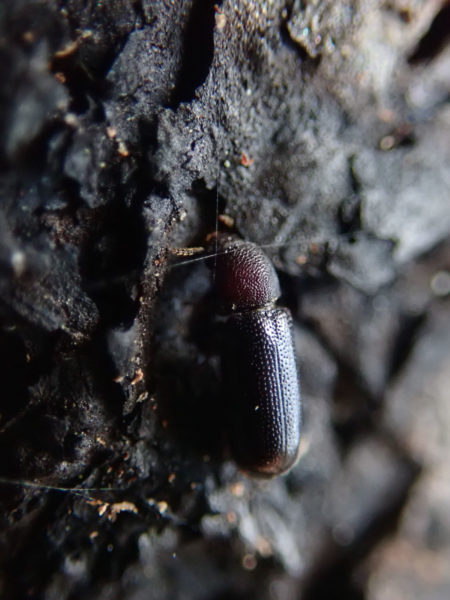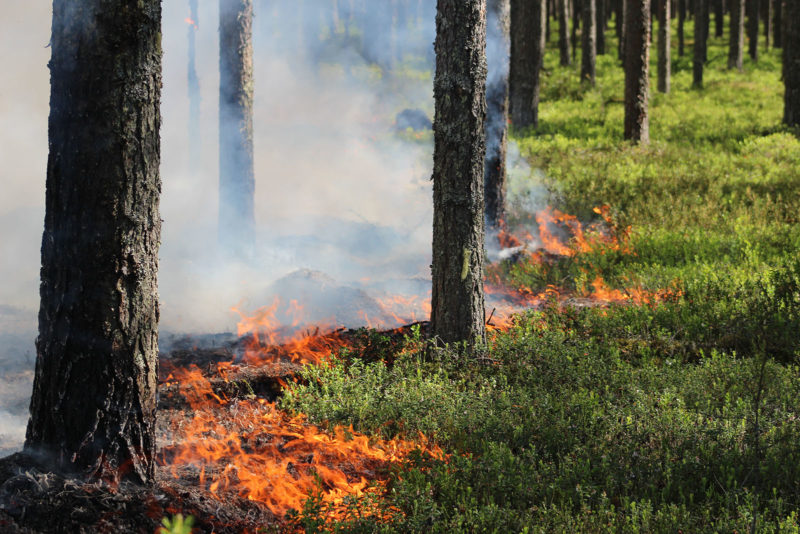Wildfires in Russia affect nature on Finland’s eastern border

Controlled restoration burnings in Finnish forests attracted up to 200 beetle species found in Finnish nature to the sites, including numerous threatened or otherwise rare species.
Controlled restoration burnings carried out in state forests by Metsähallitus last years have created new environments to hundreds of insect species.
After the burning of one of the sites, almost half of all the beetles found on fire sites in Finland and half of the Aradus species in Finland were found there. On some sites, up to 200 beetles inhabiting deadwood arrived the very first year after the operation. Polypores and other fungi and lichens, as well as insect-eating birds, also arrived on the sites.
Plenty of species dependent on deadwood always arrive on fire sites from the nearest adjacent forests, where they inhabit spontaneously created deadwood – typically, the range and ecological value of the species increases with the quality and age of the nearby forests.
’Plenty of species dependent on deadwood always arrive on fire sites from the nearest adjacent forests, where they inhabit spontaneously created deadwood – typically, the range and ecological value of the species increases with the quality and age of the nearby forests,’ says Sampsa Malmberg, Conservation Specialist at Metsähallitus.
Because burned-down forest is one of the rarest habitats in Finland, Metsähallitus has carried out restoration burnings on 14 sites during the past four years; the total area is 344 hectares. Of the beetles found in Finland, 37 species favour fire sites as their primary or secondary habitat. In addition, some of the burnings on conservation sites promoted the growth of aspen seedlings, vitally important for hundreds of other species.

Subsequent inventories on the sites found a great difference in the range of beetle species found in burned and unburned areas. The number of species found in burned areas was 1.5–2 times that found in unburned areas.
In terms of the number of individuals found, the difference was tenfold in favour of the restoration sites. The purpose of the restoration burning is to imitate natural forest fires.
Burning sites selected close to known occurrences of species
The restoration burnings focused primarily on six insect species that are defined as umbrella species. Umbrella species are organisms whose conservation indirectly protects many other species.
The beetles Stephanopachys linearis, powder-post beetle, Aradus angularis, Boros schneideri, and Phryganophilus ruficollis are either dependent on fire sites or, at the least, will benefit from access to them. Xyletinus tremulicola benefits from the aspens springing up on fire sites.
’The burning sites were selected close to known occurrences of the target species of the project, to ensure that the species could spread to the fire sites. Subsequent monitoring found that in most cases this was successful. It’s clear that the burning was needed,’ says Malmberg.
For millions of years, forest fires have played a part in the life of the boreal conifer forest. From the 17th century up to the mid-1850s, about one percent of the pine-dominated forests in Finland burned down each year. The fact that fires are now much less frequent is the primary cause of 21 forest species becoming threatened and six insect species having disappeared from Finland.
Some trees die, but others survive
In a restoration burning the fire is allowed to spread under control on the forest floor, normally on a site of former commercial forest.
Most of the burnings in the Metsähallitus project were carried out on sites that had been burned regularly for years before the project was started. Some, however, were carried out on other sites.

Another favourable factor was closeness to the border against Russia. On hot summers, smell and smoke from forest fires in Russia have been carried over to Finland even from fires hundreds of kilometres away. Finland and Russia share approximately 1300 kilometers of common land border.
’Across the border, forest fires are more common than in Finland, which also helps the survival of species dependent on fire sites,’ Malmberg says.

In the west of Finland, in contrast, species dependent on fire sites have declined or even disappeared.
’These species are constantly faced with the challenge of finding new fire sites within the range that they can travel, as soon as the current fire site changes character and is no longer suitable,’ Malmberg says.
Biodiversity benefits more important than climate drawbacks
As a method of nature management, controlled burning is unfamiliar to most Europeans, while on the other hand, dangerous wildfires have increased in all parts of the world and the amount of atmospheric carbon dioxide is increasing.
In a forest fire, carbon dioxide is released into the atmosphere with the burning of timber and vegetation on the forest floor. The controlled burning of ten hectares (corresponding to about 14 soccer fields) corresponds to the average annual use of 80 passenger cars.
Restoration burnings are a balancing act between climate disadvantages and biodiversity benefits. Even though we lose some on the climate front, it is generally considered that the benefits to biodiversity are more important here.
Normally, the aim of a restoration burning is to have some of the trees die, which means that carbon dioxide will also be gradually released from decaying wood.
’Restoration burnings are a balancing act between climate disadvantages and biodiversity benefits. Even though we lose some on the climate front, it is generally considered that the benefits to biodiversity are more important here,’ Malmberg says.
As new trees replace the dead and decaying ones, more or less the same amount of carbon dioxide as was released will ultimately be stored in the forest.
EU funding enables restoration burning
The sites burned by Metsähallitus are part of the Natura network, which covers almost one fifth (18 percent) of the land area of the EU, and almost six percent of its seas. The purpose of the Natura network is to ensure the long-term preservation of the most valuable and most threatened species and biotopes in Europe.
We wouldn’t have been able to implement the project without the EU funding. The same applies to dozens of other LIFE projects, in which the share of EU funding is typically 60–70 percent of the total budget.
The restoration burnings mentioned in this article were part of the Beetles LIFE project, with a 60%-funding from the EU. The EU share came up to EUR 1,6 million. The LIFE programme is the only EU programme focused solely on the environment, nature conservation and climate action.
’We wouldn’t have been able to implement the project without the EU funding. The same applies to dozens of other LIFE projects, in which the share of EU funding is typically 60–70 percent of the total budget,’ Malmberg says.
The fire continuum will be looked after even in the future. Finland and Sweden have just initiated the Life2Taiga project, also co-funded by the EU. The total budget here is EUR 23.5 million.
Read more: Portugal collaborates with Finland to reduce forest fire risks
Read more: High stumps increase biodiversity – new instructions now available